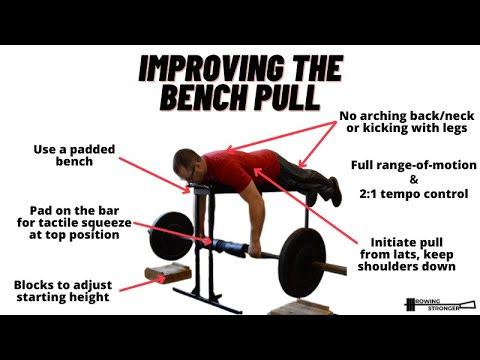My own controversial opinions about rowing training are more about what I don’t do or use in the gym than what I do.
For one, I typically don’t use “staples” of mainstream strength training with rowers: barbell bench press, back squat, and conventional deadlift.
Performance in those lifts, at least 1-rep max performance, is the sport of powerlifting. They are often fine for general fitness or recreational exercise as well. However, they have a few specific downsides for rowers pursuing specific rowing goals that get them on my “no” list compared to better alternatives.
The bench press puts direct pressure on the rib cage, at the posterior against the bench and anterior if the rower is too aggressive about bar-to-chest contact. Ribs are a costly injury in rowing, so I avoid doing things that increase stress on the chest wall area. I use dumbbell benching and pushups to gain and maintain strength and muscle mass in the horizontal pushing movement and muscles to be sufficient for rowing. These exercises also train shoulder stability better than barbell bench press. I’ve yet to coach a rower with pushups and dumbbell benching and found that their chest or triceps development was the limiting factor in their rowing performance. There are plenty of rowers who would row better/faster were it not for rib injuries.
I find that the back squat is too easy to do incorrectly or “cheat” for the sake of grinding out more reps or weight. The front squat is a superior exercise in a number of ways. Likewise for the conventional deadlift, compounded by the average tall/long-limbed rower build making it challenging to get into a good starting position at the bottom of the lift. I find the hex bar deadlift superior for rowers in every way.
I also rarely use Olympic lifts with rowers. My first coaching experience was a year-long internship with a collegiate varsity track and field team. We spent eight weeks in the fall teaching athletes 3x/wk to do the clean, clean-and-jerk, and snatch. These are talented, coordinated, explosive athletes training for triple-extension performance (which rowing isn’t). We started with PVC pipes, then lightweight training barbells, then empty barbells, then lightweight bumper plates, before beginning to challenge with load and force production during winter training to peak in the spring. We still did conventional strength training exercises during this whole time, because they sure weren’t getting stronger from the light Olympic lifts.
Potentially inflammatory among some rowing circles is my opinion that the bench pull is at best a waste of time for rowers, and at worst a significant injury risk for the all-too-common rib injury. I have recently updated my “Why I Hate the Bench Pull for Rowing” article, though, because–hold onto your seatpads–we’ve been doing them a bit with the GRP.
The rowers are expected to do bench pulls when they go to national selection camps, so we need to prepare accordingly. Fortunately, it’s not a complex exercise, so by “a bit,” I mean that we do one set of 10-20 reps at a self-selected weight as part of our warm-up series. Anyone with active or history of rib pain does bodyweight rows instead. I coach it like any other exercise with good technique (shoulders down as an upper body pull), full range-of-motion (arms straight at the bottom and squeeze at the top), and tempo control (2:1 lowering:lifting ratio). I did a new video for all of this here. This technique gets more out of the exercise and also reduces the weight that the rowers can do, therefore also reducing rib stress. Then we move on to the important work, and the bench pull bench resumes its useful role as a notebook stand. In the actual workout, we do all the other horizontal pulling exercises that I prefer for better transfer and less/no rib stress.




